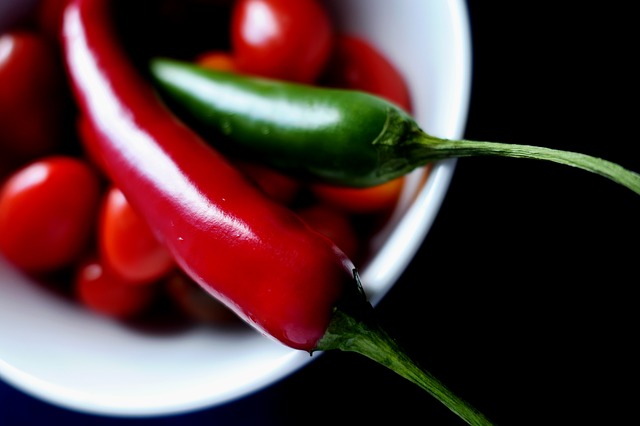Just like many things in life it comes down to individual taste but if you are part of the many who enjoy some heat with your meal or beverage then read on. The benefits of enjoying chilli in your diet go beyond the unique experience chilli provides to your food or drink.
Using chilli (also called capsicum annum) as a flavour enhancer can benefit your health in many ways such as if you use it instead of salt as this is a great way to keep your blood pressure in a healthy range. Heart disease is the number one killer of both men and women in Australia and by making small substitutions like how you add flavour to your meal can make a huge difference in the long term to your health. Chilli has minimal amount of calories and if substituted over other sugar or fat rich sauces like mayonnaise or BBQ sauce it can help maintain a healthy waistline. Lots of us are unaware of just how many calories sneak into our foods simply from sauces alone so be one step ahead of the game and prevent falling victim to this.
The health benefits to your heart do not stop only at substitution for salt. It has been found those who ate 30g of a chilli blend containing 55% chilli in the mix resulted in both men and women less likely to have their ‘bad’ LDL-Cholesterol oxidised. This means the LDL-cholesterol does not cause damage to your heart cell wall by building a plaque and clog the blood flow, this is what eventually causes a heart attack or stroke.
Do you have diabetes? Chilli may help reduce the insulin spike which happens after you eat a meal containing any form of carbohydrate. The participants who ate a 30g blend containing 55% chilli with their meal had a lower insulin spike compared to those without the chilli blend. This is good news as a lower and longer spike helps maintain your energy for longer and stops you experiencing the ‘hitting the wall’ feeling which can lead to overeating to get over this sensation.
Interested in what chilli could do for your waistline? It appears capsaicin which is the active ingredient in chilli may increase the diet induced thermogenesis in your body. What this means is when you eat you always burn energy to metabolise the food or drink but the amount you burn depends on the composition of carbohydrates, proteins and fats. This study found participants who ate a breakfast containing a mix of chilli in oil increased their diet induced thermogenesis by more than 50% compared to the other participants without this addition to the oil.
The good news for weight management doesn’t stop there! Chilli has also been studied in its ability to reduce appetitive and energy intake. A study over 6 weeks found that chilli could help suppress hunger pangs when the amount you ate over a day was less than the amount you spent in energy. This could mean if you are on the pathway to healthy weight loss then chilli may assist you resist the urge to reach for the doughnut as hunger is less likely to strike. Most of us are not used to feeling hungry anymore as we are surrounded by food 24 hours a day and this spice may help you mentally to make the changes long term.
How much chilli do you need to help with weight loss? One strong study design found significant results in 6mg of capsinoids a day reduced abdominal fat (the type you don’t want as it is associated with heart disease) and increased fat burning.
A word of warning if you suffer from reflux you may want to select a different spice or herb as this is a common trigger and can make symptoms worse.
Take home message: for most of us enjoying chilli as part of a meal can be both enjoyable in the initial taste and heat this spice provides but can also potentially give your body additional health benefits, who’s up for some heat with their next meal?
References:
- Ahuja, K. D. K., & Ball, M. J. (2006). Effects of daily ingestion of chilli on serum lipoprotein oxidation in adult men and women. The British Journal of Nutrition, 96(2), 239-42. doi:http://dx.doi.org/10.1079/BJN20061788.
- Clegg, M. E., Golsorkhi, M., & Henry, C. J. (2013). Combined medium-chain triglyceride and chilli feeding increases diet-induced thermogenesis in normal-weight humans. European Journal of Nutrition, 52(6), 1579-85. doi:http://dx.doi.org/10.1007/s00394-012-0463-9.
- Reinbach, H. C., Smeets, A., Martinussen, T., Møller, P., & Westerterp-Plantenga, M. (2009). Effects of capsaicin, green tea and CH-19 sweet pepper on appetite and energy intake in humans in negative and positive energy balance. Clinical Nutrition (Edinburgh, Scotland), 28(3), 260-265. doi:http://dx.doi.org/10.1016/j.clnu.2009.01.010
- Snitker, S., Fujishima, Y., Shen, H., Ott, S., Pi-Sunyer, X., Furuhata, YTakahashi, M. (2009). Effects of novel capsinoid treatment on fatness and energy metabolism in humans: Possible pharmacogenetic implications. The American Journal of Clinical Nutrition, 89(1), 45-50. doi:http://dx.doi.org/10.3945/ajcn.2008.26561
- Ahuja, K. D., Robertson, I. K., Geraghty, D. P., & Ball, M. J. (2006). Effects of chili consumption on postprandial glucose, insulin, and energy metabolism. The American Journal of Clinical Nutrition, 84(1), 63-69. Retrieved from https://search.proquest.com/docview/68616955?accountid=34512








